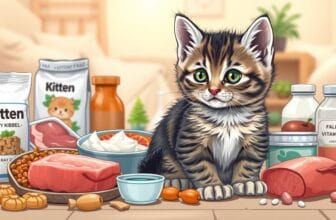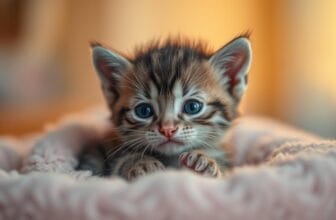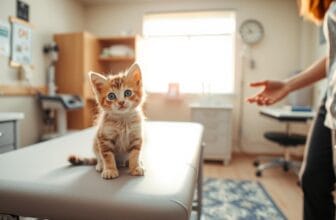
Table of Contents
Ever wondered about the amazing cats beyond regular house cats? Exotic kitten breeds open a world of unique felines. They challenge what we think we know about cats.
In the world of rare cat breeds, some cats are truly special. They are not just pets but living art. They show nature’s incredible diversity and creativity.
These cats range from hairless to wild-looking, capturing the hearts of cat lovers everywhere. Each breed has a unique story. They show how cats have evolved and been bred to be different.
Exploring exotic kitten breeds will show you cats with amazing traits. These rare cats change how we see cats. They invite us into a world most people don’t know about.
Get ready to be amazed by the variety of cats on our planet. Some are so rare and unique, they’ll surprise you about our furry friends.
Understanding Rare Cat Breeds: A Growing Fascination
The world of rare cat breeds is fascinating. It draws in pet lovers and animal enthusiasts. While many know common cats, rare ones are unique and intriguing.
Understanding what makes a cat breed rare is key. Breed development is crucial in creating these special cats.
What Makes a Cat Breed Rare
Several factors make a cat breed rare:
- Limited breeding populations
- Recent genetic mutations
- Specific geographical origins
- Challenging breeding requirements
The Appeal of Uncommon Breeds
Cat lovers are drawn to rare breeds for their unique characteristics. These cats offer:
- Distinctive physical appearances
- Rare genetic traits
- Exclusive ownership experience
- Conversation-starting pets
History of Breed Development
The evolution of rare cat breeds shows human creativity and genetic innovation. Through selective breeding, humans have turned unique genetic traits into breed standards.
| Breed Origin | Rarity Factor | Unique Characteristic |
|---|---|---|
| Natural Mutation | High | Spontaneous Genetic Change |
| Geographic Isolation | Medium | Regional Genetic Pool |
| Intentional Breeding | Low | Controlled Genetic Selection |
Pedigree cats make up only two to four percent of owned cats. This makes each rare breed a special find for those who love cats.
The Mystical Khao Manee: Thailand’s Diamond-Eyed Treasure
Explore the magical world of the Khao Manee, a rare Thai cat breed. It charms cat lovers with its stunning looks and deep cultural roots. These white cats with odd eyes are a true marvel of beauty, coming from Thailand’s royal courts.
The Khao Manee is known for its pure white coat that shines like a pearl. Their eyes are what truly make them magical. They can have:
- Brilliant blue
- Striking gold
- Heterochromatic (one blue, one gold)
In the past, Khao Manee cats were seen as royal treasures in Thailand. They were believed to bring good luck. This made them highly valued, with their name meaning “white gem.”
“A Khao Manee is not just a cat, but a living piece of Thai cultural heritage.” – Feline Breed Experts
Thinking of getting a Khao Manee? Be ready for a unique pet. These cats are known for being:
- Playful and smart
- Very attached to their human families
- Easy to care for
While they are rare and might cost more, a Khao Manee offers a special pet experience. Their unique looks and genetics make them a great conversation starter and a beloved companion.
Burmilla: The Accidental Silver Beauty
Explore the captivating world of Burmilla cats, a rare silver cat breed. They came to be through a surprising genetic mix. These cats are among the most fascinating accidental cat breeds in history.
In the 1980s, in England, a Burmilla breed was born by chance. A Burmese cat and a Persian chinchilla had an unexpected meeting. This led to the creation of a beautiful silver kitten, starting a new breed.
Origins and Development
Burmilla cats came from a single, unplanned breeding. A Burmese female and a Persian chinchilla male had an accidental encounter. This resulted in kittens with striking silver coats and unique markings.
- Breed originated in the United Kingdom
- First documented in 1981
- Recognized as a distinct breed in the late 1980s
Physical Characteristics
Burmilla cats have a stunning silver coat. Their fur can be shaded or tipped, giving them a magical look.
- Medium-sized body
- Large, expressive eyes
- Soft, dense coat with metallic sheen
- Colors include silver, golden, and bronze
Temperament and Personality
Burmilla cats are known for their playful and loving nature. They combine the intelligence of Burmese cats with the gentle nature of Persians.
“Burmillas are like living works of art – beautiful, intelligent, and endlessly charming.” – Cat Breed Enthusiast
Whether you’re a seasoned cat lover or new to pets, Burmillas are unique. They offer a mix of beauty, personality, and charm that sets them apart.
The Exotic Kitten Breeds Revolution
The world of designer cat breeds has changed a lot lately. Exotic kitten trends are changing how we see cats. Now, cats are celebrated for their special looks and personalities.
Social media has helped make rare cat breeds popular. Sites like Instagram and TikTok show off these unique cats. This has made many people interested in them.
- Spotted coats that mimic wild ancestors
- Unusual body structures and sizes
- Rare color combinations
- Distinctive genetic traits
Now, people want extraordinary companions that are different from regular cats. The demand for exotic kittens has gone up. People love their unique looks and traits.
| Breed Category | Unique Features | Popularity Trend |
|---|---|---|
| Hairless Breeds | Smooth skin, minimal grooming | Rapidly increasing |
| Hybrid Breeds | Wild ancestry, distinctive markings | Strong growth |
| Miniature Breeds | Unusually small size | Steadily rising |
The excitement for exotic kittens is still growing. But, it’s important to own them responsibly. Owners need to learn about their needs and health. They must also make sure they can take good care of these special cats.
“Exotic cats are not just pets – they’re living art with unique personalities.” – Feline Genetics Expert
Sokoke: Africa’s Forest Dwelling Feline
In Kenya’s lush forests, the Sokoke cats are a unique and captivating breed. They have won the hearts of cat lovers around the world. These forest cats show the wild spirit of their home, giving us a peek into East Africa’s rich wildlife.
Found in Kenya’s coastal woodlands, Sokoke cats have a special story. They are different from other domestic cats. Their traits help them survive in tough terrain.
Natural Habitat and History
The Sokoke’s history is tied to the Arabuko-Sokoke Forest in Kenya. Local people saw these cats as skilled hunters living freely in the forest. Their survival skills and adaptability make them truly special:
- Native to coastal Kenya’s dense forest regions
- Developed natural camouflage through unique coat patterns
- Recognized as a distinct breed in the late 20th century
Distinctive Features
Sokoke cats have a striking look that shows their wild roots. Their coat has a distinctive tabby-like pattern for great camouflage. Key features include:
- Medium-sized muscular body
- Short, close-lying coat with unique striped markings
- Large, alert ears
- Agile and athletic build
Care Requirements
Thinking of getting a Sokoke cat? Knowing their needs is key. These active and smart cats need:
- Plenty of mental and physical stimulation
- Interactive play sessions
- High-quality protein-rich diet
- Regular veterinary check-ups
Sokoke cats do well in places where they can explore and hunt. They are great for experienced owners who love their unique background and lively nature.
LaPerm: The Curly-Coated Wonder
Imagine a cat with hair that looks like it just came from a salon. That’s the LaPerm, a unique curly-haired cat. Their fur is soft and bouncy, making them stand out.
The LaPerm breed started with a special genetic find in the 1980s. A barn cat named Speedy had a kitten with curly fur. This was the start of this amazing breed. LaPerm cats have won many hearts with their looks and sweet nature.
- Unique curly coat that comes in both long and short varieties
- Soft, springy texture that feels like a gentle perm
- Medium-sized breed with an athletic build
- Friendly and interactive personality
LaPerm cats are easy to groom. Their curly fur doesn’t tangle much. This makes them great for families who don’t want to spend a lot of time on grooming. They are playful and loving, often becoming very close to their owners.
The LaPerm is proof that sometimes the most unexpected genetic changes can create something truly magical in the world of cats.
If you want a pet that’s both unique and loving, the LaPerm is perfect. Their curly fur is sure to catch everyone’s eye. They bring happiness to any home that loves cats.
Turkish Van: The Swimming Cat Phenomenon
Imagine a cat that loves water more than most dogs! Turkish Van cats are truly unique. They have a deep passion for swimming. These cats come from eastern Turkey and have white coats and amazing swimming skills.
Historical Background
The Turkish Van breed comes from Lake Van in Turkey. These cats love water, unlike most cats. Their homeland’s mountains and water sources helped them become natural swimmers.
Unique Swimming Abilities
Turkish Van cats are special because they love water. They have:
- Water-resistant fur that keeps them dry
- Muscular bodies perfect for swimming
- A natural curiosity about water
- A playful attitude towards water
Care and Training
Caring for a Turkish Van means understanding their active nature. They need:
- Regular swimming sessions
- Interactive water play
- High-energy exercise
- Mental games in water
Pro tip: Always supervise your Turkish Van during water activities to ensure their safety and enjoyment!
Minskin: The Miniature Marvel
Explore the world of Minskin cats, a unique miniature breed that fascinates many. They are a mix of the Sphynx and Munchkin breeds. Their small size and minimal fur make them stand out.
Minskin cats are small, weighing 4-6 pounds. They have a sparse, soft coat. Their body is mostly hairless, with fur on their ears, nose, and paws. This gives them a special look.
- Originated in the early 2000s
- Developed by combining Sphynx and Munchkin breeds
- Recognized for their tiny, compact body
- Partial hairless coat with fur points
Minskin cats are friendly and playful. They love being around people and are great with families. Their small size is perfect for those living in apartments or with limited space.
| Characteristic | Details |
|---|---|
| Average Weight | 4-6 pounds |
| Coat Type | Mostly hairless with fur points |
| Temperament | Friendly, playful, social |
| Lifespan | 12-15 years |
Caring for Minskin cats is special. You need to protect their skin from the sun and bathe them regularly. Despite their size, they are full of energy and need lots of play and interaction.
Peterbald: Russia’s Elegant Hairless Beauty
Russian cat lovers treasure the Peterbald, a unique and elegant breed from St. Petersburg. These Russian hairless cats are a peak of feline elegance. They have stunning looks and an interesting genetic background.

The Peterbald breed started in 1994. It was created by mixing Oriental Shorthair and Donskoy breeds. This mix made a truly special cat that stands out among elegant breeds.
Unique Physical Characteristics
These cats have:
- Triangular head shape with big ears
- Varying coat types, from hairless to short-haired
- Slim, muscular body
- Large, expressive eyes
Special Care Requirements
Caring for Peterbald cats needs extra attention. Their sensitive skin needs:
- Regular baths to manage skin oils
- Protection from extreme temperatures
- Gentle skin moisturizing
- Sunscreen when they go outside
“The Peterbald is not just a cat, but a living work of art from Russia’s feline world.” – Cat Breed Enthusiast
Whether fully hairless or with a fine coat, Peterbald cats win hearts with their elegant looks and loving nature. Their unique genetics and stunning appearance make them a marvel among cat breeds.
The American Bobtail: Wild Look, Gentle Heart
American Bobtail cats are unique short-tailed cats that capture the hearts of cat lovers. They have a wild-looking domestic cat appearance. These fascinating felines combine a rugged exterior with an incredibly gentle temperament.
They are perfect companions for active families. The breed stands out with its distinctive physical characteristics. Their muscular build and natural short tail give them an almost wildcat-like appearance.
Despite looking like they just stepped out of the wilderness, American Bobtail cats are known for their loving and playful personalities. They are highly intelligent and easily trainable. This makes them adaptable to various home environments.
- Natural short tail that sets them apart from other breeds
- Muscular and athletic body structure
- Highly intelligent and easily trainable
- Adaptable to various home environments
One of the most remarkable traits of American Bobtail cats is their incredible trainability. Unlike many cat breeds, they enjoy interactive activities. They can be easily leash trained.
You might find yourself taking your Bobtail for walks or playing complex games. These games challenge their sharp minds.
The American Bobtail: A perfect blend of wild appearance and domestic charm!
When considering an American Bobtail, potential owners should be prepared for an energetic and social companion. These cats thrive on interaction and love being part of family activities. Their adaptable nature makes them excellent pets for families with children, other pets, and active lifestyles.
Cornish Rex: The Velvet-Coated Athlete
Cornish Rex cats are truly unique in the world of cats. They have a special look and a lively personality. Their soft, curly fur and strong body make them a hit with cat lovers.
The Cornish Rex cat’s amazing coat is a genetic wonder. Their fur is soft and wavy, feeling like velvet. This special coat comes from a rare genetic change that makes their fur curl tightly all over.
Distinctive Coat Structure
Cornish Rex cats have a coat that’s unlike any other. It’s known for:
- Extremely short, tight curls covering the entire body
- Incredibly soft, wave-like texture
- Minimal shedding compared to other cat breeds
- A genetic mutation that creates their signature look
Exercise and Enrichment Needs
Cornish Rex cats are very active and need lots of play. They have a lot of energy and need fun activities. You should give them:
- Climbing trees and vertical spaces
- Interactive puzzle toys
- Daily play sessions
- Opportunities for hunting-like activities
Health Considerations
Cornish Rex cats are usually healthy but have special needs. Their thin coat makes them sensitive to cold or hot weather. They need regular vet visits and a good diet to stay healthy and active.
Arabian Mau: Desert Beauty

Meet the Arabian Mau, a unique cat breed from the Middle East. They are built for desert life, with special traits that make them stand out. These cats have adapted to the harsh conditions of the Arabian Peninsula.
Arabian Mau cats have a rich history. They originated in the desert, where they learned to survive extreme heat and tough terrain. Their bodies and coats are made for hot weather.
- Native to the Middle Eastern desert regions
- Exceptional hunting skills
- Highly adaptable to extreme environments
- Independent yet affectionate temperament
These cats are a mix of wild and tame. They are great hunters and loving pets. Arabian Mau cats are smart, alert, and very agile.
“The Arabian Mau represents the perfect balance between wild survival instincts and domestic companionship.” – Feline Breed Experts
Thinking about getting an Arabian Mau? They need lots of mental and physical activity. They also need a place to hunt. Their short coat is easy to groom.
If you’re interested in rare cats or desert animals, the Arabian Mau is a great choice. They offer a unique experience that connects you to the Middle East’s natural heritage.
Chausie: The Mini Jungle Cat
Explore the world of hybrid cat breeds with the Chausie. This cat is a mix of domestic and wild cat traits. It’s a favorite among cat lovers who want something special.
Wild Ancestry Revealed
Chausie cats come from a unique mix of domestic and jungle cat breeds. They were created in the 1990s to blend domestic traits with wild cat features. Their roots go back to the Felis chaus, a wild cat from Southeast Asia.
- Original breeding began in the 1990s
- Developed from domestic cat and jungle cat crossings
- Recognized as a unique breed by The International Cat Association (TICA)
Modern Breed Standards
The modern Chausie has a sleek, athletic look. It shows its wild side. Breed standards highlight physical traits that set it apart from other domestic cats.
| Characteristic | Description |
|---|---|
| Size | Medium to large |
| Weight | 15-20 pounds |
| Coat | Short, smooth, minimal grooming required |
| Colors | Black, brown, and silver varieties |
Living with a Chausie
Getting a Chausie means you’re in for a big commitment. They need lots of mental and physical activity. You’ll need to play with them, give them toys, and make sure they get enough exercise.
- Provide tall climbing structures
- Engage in daily interactive play
- Create stimulating indoor environments
- Ensure consistent training and socialization
Chausie cats are not your average house cat. They come from a wild background. So, they need an owner who knows how to care for them properly.
Ojos Azules: The Blue-Eyed Wonder
Explore the captivating world of Ojos Azules cats. They are a rare breed known for their stunning blue eyes. These cats are truly unique among blue-eyed breeds.
The name Ojos Azules means “blue eyes” in Spanish. It perfectly describes their most striking feature. Unlike other blue-eyed cats, Ojos Azules can have any coat color but always have blue eyes. This rare trait makes them stand out.
- Unique blue eye coloration regardless of coat color
- Rare genetic mutation responsible for eye color
- Playful and social temperament
- Extremely limited breeding population
Genetic studies show that Ojos Azules cats have a special mutation for their blue eyes. This rare trait doesn’t harm their health. It makes them interesting to both cat lovers and scientists.
| Characteristic | Description |
|---|---|
| Origin | United States |
| Eye Color | Deep Blue |
| Coat Variety | All Colors Possible |
| Temperament | Social and Playful |
Looking for a unique pet? Ojos Azules cats are a captivating choice. They offer a mix of striking looks and a loving personality. Their rarity makes them a special addition to any home, bringing both beauty and affection.
The Rare Breed Journey: From Kitten to Cat
Raising an exotic kitten needs special knowledge and dedication. Your journey starts with knowing their unique needs and creating a supportive environment.

Exotic kitten care is different from regular cat care. These special cats need more attention in their early development.
Navigating Early Development Stages
Raising a rare breed cat comes with its own set of challenges. The first few months are crucial for:
- Building strong immune systems
- Developing social skills
- Forming strong bonds with humans
Specialized Care Requirements
Socializing unusual cats requires careful nutrition and health monitoring. Here are some key care tips:
- Regular vet visits are a must
- Choose the right food for your breed
- Make sure their environment is stimulating
“Understanding your exotic kitten’s unique needs is the key to raising a healthy, well-adjusted companion.” – Feline Genetics Research Institute
Training and Socialization Strategies
Early and consistent socialization is key for exotic kitten development. Patience and positive reinforcement are essential. They help your rare breed cat become confident and adaptable.
By focusing on your exotic kitten’s specific needs, you lay a strong foundation for a lifelong bond with your extraordinary feline friend.
Conclusion
Exploring exotic cat ownership is a journey into extraordinary feline companionship. These rare breeds offer a unique chance to have a distinct pet. Before getting one, you must do thorough research and prepare well.
The world of unique pets is both thrilling and demanding. Each breed has special traits and care needs. It’s important to understand these to have a good relationship with your cat.
Before getting a rare breed, think about your lifestyle and space. You also need to be ready to provide the special care they need. This includes attention, vet visits, and learning about their genetic background.
These cats are more than pets; they connect us to their genetic and evolutionary stories. By loving and understanding them, you can form a deep bond. This bond goes beyond what you might experience with other pets.
FAQ
What defines an exotic kitten breed?
Exotic kitten breeds are rare and have unique looks. They often have special traits that make them stand out. These cats are not as common as others.
Are exotic cat breeds more expensive than traditional breeds?
Yes, exotic cat breeds cost more. This is because they are rare and need special care. Prices can be high, ranging from hundreds to thousands of dollars.
How difficult is it to care for an exotic kitten breed?
The care needed varies by breed. Exotic kittens might need special food, grooming, and health checks. Some breeds need extra care for their unique traits.
Are exotic cat breeds good for families with children?
Not all exotic breeds are good for families. Some, like the American Bobtail, are gentle and fun. Others might be too independent or have special needs. Always check the breed’s personality before getting one.
Do exotic cat breeds have more health issues?
Some exotic breeds can have health problems. For example, hairless breeds need special skin care. Hybrid breeds might have more health concerns. Regular vet visits are key to keeping them healthy.
How can I ensure I’m purchasing an exotic kitten from a responsible breeder?
Do your homework by checking the breeder’s credentials and health records. Visit the breeding facility and meet the kitten’s parents. Good breeders will share the breed’s history and answer your questions.
Are exotic cat breeds hypoallergenic?
Not all exotic breeds are hypoallergenic. Some, like the Sphynx, have less hair and might be better for allergies. But, no cat is completely hypoallergenic. Always test your reaction to the breed before getting one.
How long do exotic cat breeds typically live?
Most exotic cat breeds live 12 to 15 years. Proper care, food, and vet visits can help them live longer and healthier.
Can exotic cat breeds be kept as indoor pets?
Many exotic breeds are great for indoor living. But, some, like the Chausie, need lots of activity. Make sure you can provide enough play and exercise for these active breeds.
Do exotic cat breeds require special diets?
Some exotic breeds need special food. For example, hairless breeds might need more calories. Always talk to a vet to find the best diet for your exotic breed.







